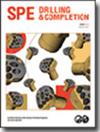Stress Analysis of Variable Ram Blowout Prevention Valves
IF 1.2
4区 工程技术
Q3 ENGINEERING, PETROLEUM
引用次数: 1
Abstract
Variable ram blowout prevention (VRBOP) valves are elastomeric material-based flow control devices used in offshore oil drilling applications as the primary safety mechanism to respond to high wellbore pressure emergency situations. During their operation, the elastomer deforms and distorts extensively to form a tight seal around the drillpipe. Because of the large deformation and distortion of the elastomer, developing a Lagrangian-based finite element analysis model to simulate the operation of a VRBOP valve is quite challenging. The finite elements of the Lagrangian finite element mesh degrade in quality because they deform with the material when the deformation becomes excessive. This leads to poor convergence of the numerical solution. In this study, we first demonstrate that the numerical convergence issues can be resolved by using a suite of modeling techniques: explicit integration scheme, Ogden second-order hyperelastic constitutive model for the elastomer, and the selection of appropriate values for element sizes and other modeling parameters. After resolving the convergence issues, we used the model to study the sealing efficiency and material failure of a VRBOP valve for two different operating temperatures and drillpipe diameters. The sealing efficiency is studied using two performance criteria: the uniformity of the sealing pressure around the drillpipe and the magnitude of the overall deformation of the elastomer. For the material failure analysis of the elastomer, we used multiple failure criteria. The results of this study provide many new insights that have the potential to improve VRBOP valve design. For instance, results show that elevated temperature improves the sealing efficiency of a VRBOP valve because of the higher flexibility of the elastomer at elevated temperatures. Likewise, the wellbore pressure also improves the sealing efficiency. However, all these improvements in sealing pressure come with the risk of a higher probability of material failure.可变闸板防喷阀的应力分析
可变闸板防喷阀(VRBOP)是一种基于弹性材料的流量控制装置,用于海上石油钻井应用,作为应对高井筒压力紧急情况的主要安全机制。在操作过程中,弹性体会发生大范围变形和变形,从而在钻杆周围形成紧密密封。由于弹性体的大变形和畸变,开发一个基于拉格朗日的有限元分析模型来模拟VRBOP阀的运行是非常具有挑战性的。拉格朗日有限元网格的有限元在质量上会降低,因为当变形变得过大时,它们会随材料变形。这导致数值解的收敛性较差。在这项研究中,我们首先证明了数值收敛问题可以通过使用一套建模技术来解决:显式积分方案、弹性体的Ogden二阶超弹性本构模型,以及选择适当的单元尺寸和其他建模参数值。在解决收敛问题后,我们使用该模型研究了在两种不同操作温度和钻杆直径下VRBOP阀的密封效率和材料失效。使用两个性能标准来研究密封效率:钻杆周围密封压力的均匀性和弹性体整体变形的大小。对于弹性体的材料失效分析,我们使用了多种失效标准。这项研究的结果提供了许多新的见解,有可能改进VRBOP阀门的设计。例如,结果表明,升高的温度提高了VRBOP阀的密封效率,因为弹性体在升高的温度下具有更高的柔性。同样,井筒压力也提高了密封效率。然而,密封压力的所有这些改进都伴随着材料失效概率更高的风险。
本文章由计算机程序翻译,如有差异,请以英文原文为准。
求助全文
约1分钟内获得全文
求助全文
来源期刊

SPE Drilling & Completion
工程技术-工程:石油
CiteScore
4.20
自引率
7.10%
发文量
29
审稿时长
6-12 weeks
期刊介绍:
Covers horizontal and directional drilling, drilling fluids, bit technology, sand control, perforating, cementing, well control, completions and drilling operations.
 求助内容:
求助内容: 应助结果提醒方式:
应助结果提醒方式:


